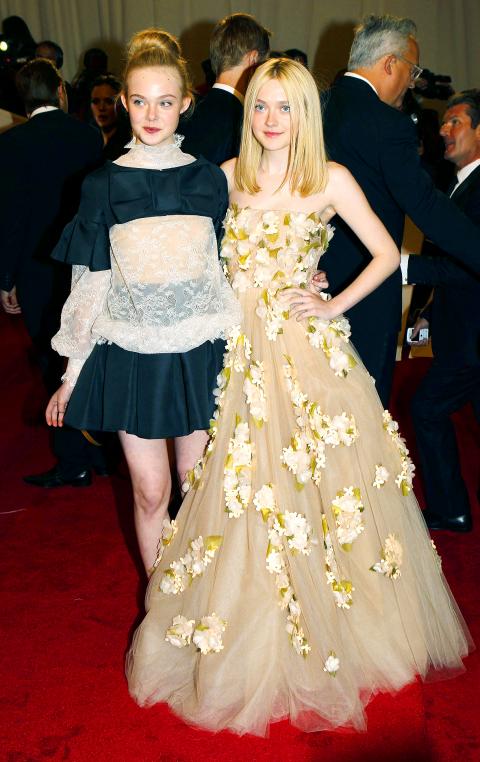In Vogue’s August “age issue,” editors gush about the style proclivities of the teenage Fanning sisters, Dakota and Elle, who appear in a full-page photograph turned out in puff-sleeved glad rags from Louis Vuitton.
Elle, who described her look that day as “‘Virgin Suicides’ meets Twiggy,” is “remarkably sartorially erudite for a 13-year-old,” it was noted. She, you may recall, has been showcased in Marc Jacobs’ advertising campaigns since she was 11. She also has appeared in short films by Laura and Kate Mulleavy of Rodarte.
She has plenty of company. Hailee Steinfeld, 14, who was nominated for an Oscar for her role in True Grit, was zipped into a Prada mermaid dress for her star turn on the red carpet. The sartorial whims of the tweenage “it” girls Chloe Moretz, 14, and the 10-year-old pop star Willow Smith are avidly charted by the fashion flock.

Photo: Reuters
The list goes on, prompting one to wonder where it all will end. Hollywood tweens are, after all, but the latest style-world idols. Members of the Play-Doh and Nickelodeon set are sprouting up fast alongside them, dotting a landscape in which, it would seem, one can never be too groovy — or too young.
Pint-size fashion pundits are hailed as muses and cast in major ad campaigns. They can be spied in the front rows at fashion shows, preening on the red carpet or posing coyly on the Web.
Consider Milo Munshin, the towheaded 11-year-old creator of Purple, purpleblog.blogspot.com (not to be confused with Purple, the hyper-sexualized fashion magazine). In a recent post, Milo modeled a Louis Vuitton monogram kerchief, looping it around his waist, at his throat and, to ward off ennui, perhaps, tying it bandanna-style around his head. Milo has rubbed shoulders with Kelly Ripa. He has met Zac Posen.

Photo: Reuters
Precocious he may be, but he has nothing on Maple, a preternaturally hip 3-year-old and the inspiration behind likethetreeblog.blogspot.com. Maple’s stamp-size variations on kiddie couture are lavishly documented by Grace Damien, her mom, who snaps her, with Maple’s seemingly gleeful assent, cavorting on the beach in a miniaturized two-piece swimsuit, stringing beads or posing in a pink sunhat and petticoat.
Milo and Maple are not the first wee fashion prodigies, nor will they likely be the last (think Tavi), to be coaxed — make that thrust — into the spotlight by a doting parent or scribe. “I hope you will take a look at the blog,” Damien wrote in an e-mail to the New York Times last month, sounding very like a stage mom on Toddlers and Tiaras.
“Any additional exposure is always good,” she wrote.
Certainly, some people think so.
In a discussion of the latest spate of middle school-age Hollywood style-setters, Jane Keltner de Valle, Teen Vogue’s fashion news director, assured the Daily Beast, “What Michelle Obama did for first ladies, these girls have the potential to do for tween stars.”
“They’re making themselves viable fashion forces,” she said, “and they’re getting people excited about fashion again.”
Do tell.

June 2 to June 8 Taiwan’s woodcutters believe that if they see even one speck of red in their cooked rice, no matter how small, an accident is going to happen. Peng Chin-tian (彭錦田) swears that this has proven to be true at every stop during his decades-long career in the logging industry. Along with mining, timber harvesting was once considered the most dangerous profession in Taiwan. Not only were mishaps common during all stages of processing, it was difficult to transport the injured to get medical treatment. Many died during the arduous journey. Peng recounts some of his accidents in

“Why does Taiwan identity decline?”a group of researchers lead by University of Nevada political scientist Austin Wang (王宏恩) asked in a recent paper. After all, it is not difficult to explain the rise in Taiwanese identity after the early 1990s. But no model predicted its decline during the 2016-2018 period, they say. After testing various alternative explanations, Wang et al argue that the fall-off in Taiwanese identity during that period is related to voter hedging based on the performance of the Democratic Progressive Party (DPP). Since the DPP is perceived as the guardian of Taiwan identity, when it performs well,

A short walk beneath the dense Amazon canopy, the forest abruptly opens up. Fallen logs are rotting, the trees grow sparser and the temperature rises in places sunlight hits the ground. This is what 24 years of severe drought looks like in the world’s largest rainforest. But this patch of degraded forest, about the size of a soccer field, is a scientific experiment. Launched in 2000 by Brazilian and British scientists, Esecaflor — short for “Forest Drought Study Project” in Portuguese — set out to simulate a future in which the changing climate could deplete the Amazon of rainfall. It is

Artifacts found at archeological sites in France and Spain along the Bay of Biscay shoreline show that humans have been crafting tools from whale bones since more than 20,000 years ago, illustrating anew the resourcefulness of prehistoric people. The tools, primarily hunting implements such as projectile points, were fashioned from the bones of at least five species of large whales, the researchers said. Bones from sperm whales were the most abundant, followed by fin whales, gray whales, right or bowhead whales — two species indistinguishable with the analytical method used in the study — and blue whales. With seafaring capabilities by humans